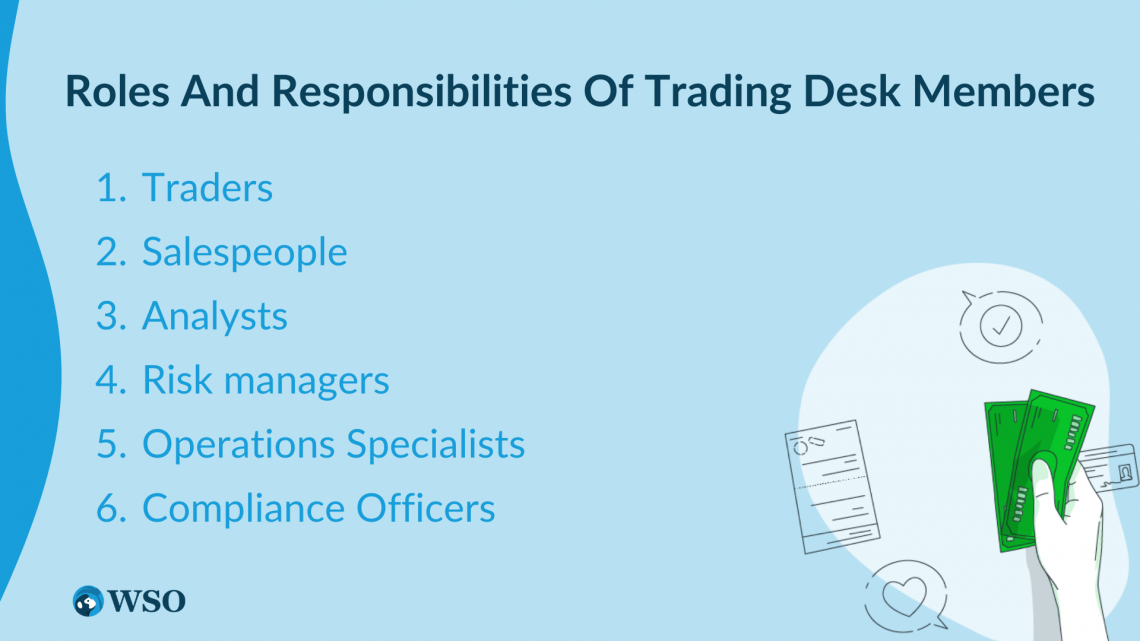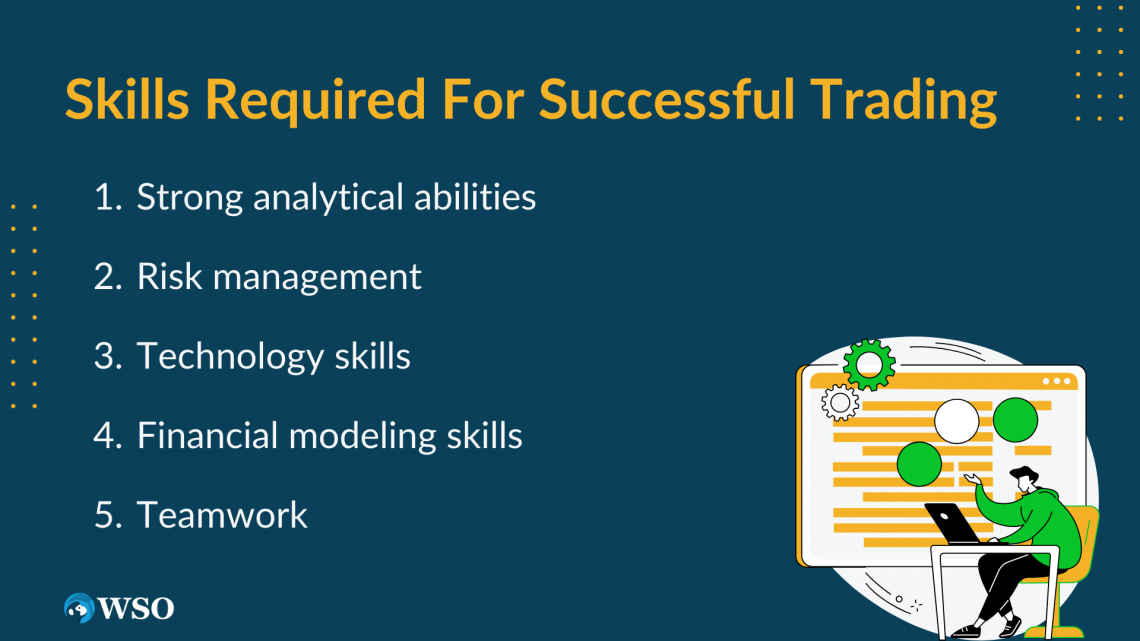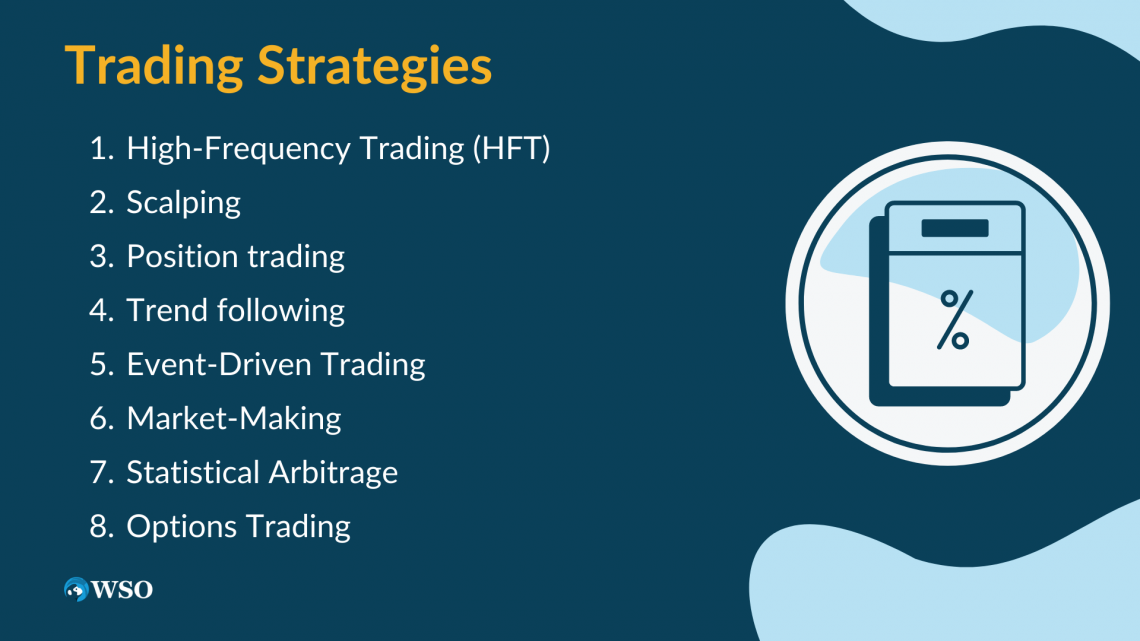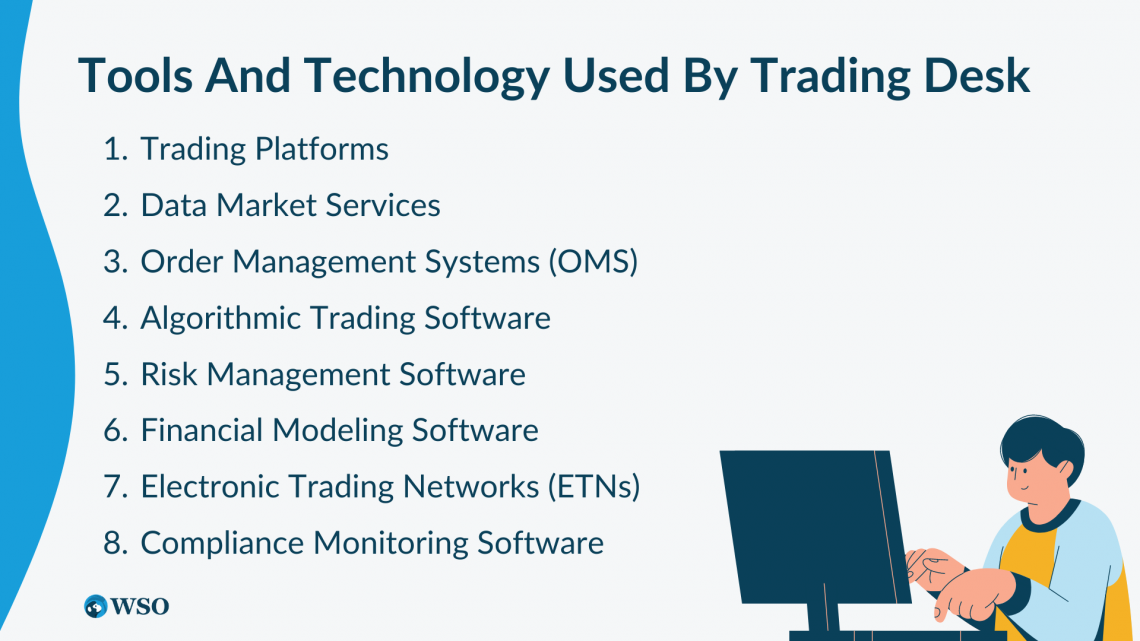Trading Desk
An actual place where transactions for buying and selling securities occur is a trading desk.
An actual place where transactions for buying and selling securities occur is a trading desk. Trading desks can be real or virtual. Many financial institutions, investment banks, hedge funds, asset management companies, and brokerage houses all have trading desks.

These trading desks have a staff of knowledgeable traders, analysts, and support staff that collaborate to track market conditions, examine financial data, and carry out deals in real-time.
They serve as the central hub where investment decisions are made, capital is created, and risk is managed. Trading platforms allow investors to profit from their investments and businesses to raise capital by issuing securities.
Additionally, they give investors a chance to protect themselves against unfavorable market fluctuations and other uncertainties, allowing them to efficiently manage risk.
The operations and strategies employed by trading desks have a significant impact on the global economy. As such, trading desks play a vital role in shaping market dynamics and contributing to overall market efficiency.
Their operations have significant effects on financial markets and the whole global economy. These are essential elements of the financial markets because they assist price discovery, improve liquidity, and give investors worthwhile investment options.

They employ expert traders, analysts, and support personnel to monitor market circumstances, analyze financial data, and carry out trades in real-time. One cannot emphasize the significance of trading platforms in the world of finance.
They are essential to capital creation because they allow investors to profit from their investments and allow businesses to raise money by issuing securities.
They also enable investors to manage risk by hedging against adverse market movements and other uncertainties.Their operations and strategies significantly impact the global economy.
Key Takeaways
- Trading platforms are physical or virtual places where securities transactions occur and are crucial to the functioning of financial markets.
- Traders, salespeople, analysts, risk managers, operations specialists, and compliance officers are all essential members of a trading desk team.
- Traders execute trades, salespeople generate new business and maintain client relationships, and analysts perform research and identify investment opportunities.
- Risk managers monitor and manage risks, operations specialists ensure smooth trading desk operations, and compliance officers ensure compliance with regulations and internal policies.
- Technology is critical in trading desk operations, including using electronic trading networks, algorithms, and artificial intelligence.
- Trading platforms allow investors to profit from their investments, help businesses raise money, and enable investors to manage risk.
- Technology, market structure changes, and a focus on environmental, social, and governance factors will likely shape the future of trading desks.
- Successful trading desk members will need to be adaptable, innovative, and possess a diverse set of skills and expertise.
Roles and Responsibilities of Trading Desk Members
According to the team size, the kinds of products traded, and the overall investment strategy, each trading may have a varied set of tasks and responsibilities.However, these roles are essential for successfully operating a trading desk and managing investment portfolios.

The following are some of the typical jobs and duties of trading desk members:
1. Traders
They are in charge of carrying out deals on the firm's or clients' behalf. They keep track of market information, examine trends, and employ their knowledge to make wise financial choices.
Traders must also manage risk, ensure regulation compliance, and maintain client relationships.
2. Salespeople
These people are responsible for generating new business and maintaining relationships with clients. They work closely with traders to understand client needs, provide market insights, and execute trades.
3. Analysts
They are tasked with performing research, offering analysis of market trends, and identifying investment possibilities.
NOTE
Analysts may use fundamental and technical analysis to identify potential investments and provide recommendations to traders and portfolio managers.
4. Risk managers
They're in charge of keeping an eye on and managing the risks posed by the activity of the trading desk. They recognize and evaluate possible risks, create risk management plans, and ensure that internal rules and laws are followed.
5. Operations Specialists
OS are responsible for ensuring the smooth operation of the trading desk. They may handle trade settlements, confirmations, and other administrative tasks. They also work closely with IT teams to ensure that trading systems and technologies run smoothly.
NOTE
Operations Specialists collaborate closely with traders and analysts to create investment plans, distribute funds, and keep track of portfolio performance.
6. Compliance Officers
They are responsible for ensuring that the trading desk operates in compliance with regulations and internal policies. They monitor trading activities, review compliance procedures, and provide training to trading desk members on regulatory requirements.
Skills Required for Successful Trading
A successful trading place requires a team of professionals with diverse skills and expertise. Good trading needs the following talents, among others.

A successful trading desk requires a diverse set of skills and expertise. Trading desk members must have strong analytical skills, risk management skills, communication skills, technology skills, attention to detail, financial modeling skills, flexibility, adaptability, and teamwork.
1. Strong analytical abilities
Traders and analysts need to evaluate market information, see patterns, and decide on investments confidently.
The ability to assess data using several tools and techniques, including statistical modeling, machine learning, and technical and basic analysis, is a must.
2. Risk management
Risk managers must be able to identify and manage risks associated with the desk's activities.
They must be able to create risk management plans that complement the firm's risk tolerance and have a thorough awareness of the risks related to various investment products and strategies.
NOTE
To build and sustain relationships with clients and other stakeholders, salesmen, traders, and analysts must possess strong communication skills to build and sustain relationships with clients and other stakeholders.
3. Technology skills
Trading relies heavily on technology to analyze market data, execute trades, and manage investment portfolios.
Trading desk members must have a strong understanding of trading platforms, order management systems, and other technologies used in trading.
4. Financial modeling skills
Analysts and portfolio managers must be able to build financial models to evaluate investment opportunities and forecast financial performance.
NOTE
Analysts and portfolio managers must deeply understand financial statements, valuation techniques, and accounting principles.
5. Teamwork
Successful trading desks rely on collaboration and teamwork. Desk members must be able to work effectively with other team members, share information and expertise, and support each other to achieve common goals.
Trading Strategies
The strategy which describes the many tactics and procedures that traders and trading desks use to decide whether to purchase or sell assets. These tactics can change depending on the trader's risk tolerance, time horizon, and market conditions.

It is crucial to remember that traders and trading desks frequently create distinctive tactics based on their knowledge, experience, and the state of the market. Successful trading strategies require careful risk management and a thorough understanding of the markets.
1. High-Frequency Trading (HFT)
A popular trading strategy, uses high-speed computers and algorithms to execute trades in milliseconds or microseconds.
HFT traders use small price discrepancies in the market to generate profits. In contrast, Algorithmic trading involves using computer programs to analyze market data and execute trades based on predetermined rules and conditions.
2. Scalping
Another popular trading strategy that involves making numerous trades within a short period, often seconds or minutes. Traders using scalping techniques aim to generate profits from small price movements in the market.
NOTE
Swing trading involves holding positions for several days or weeks and aiming to profit from medium-term price movements. Swing traders use technical analysis and chart patterns to identify potential trades.
3. Position trading
A long-term trading method called position trading entails maintaining positions for several weeks or even months.
Position traders are not much concerned with short-term price fluctuations and rather seek profit from long-term market patterns.
Arbitrage trading includes buying an item in one market and concurrently selling it in another market to take advantage of price differences between the two marketplaces.
4. Trend following
It is a trading strategy that identifies and follows market trends. Trend followers buy when prices rise and sell when prices fall, aiming to profit from the market's momentum.
NOTE
Other trading strategies include mean reversion, where traders exploit temporary price deviations from the average price, and news trading, which involves using information about economic events or company news to make trading decisions.
5. Event-Driven Trading
This strategy involves taking positions based on anticipated or actual events such as earnings announcements, mergers, acquisitions, or government policy changes.
Traders may use a combination of fundamental and technical analysis to identify potential opportunities.
6. Market-Making
This strategy involves providing liquidity to the market by buying and selling securities at bid and ask prices.
NOTE
Market makers earn profits through the bid-ask spread and may use hedging strategies to manage risk.
7. Statistical Arbitrage
This strategy involves using statistical models to identify patterns in market data and take advantage of pricing inefficiencies.
Regression analysis, time series analysis, and machine learning are just a few statistical methods traders might employ to find chances.
8. Options Trading
This strategy involves using options contracts to take positions in the direction of an underlying asset's price movement.
Options traders may use various strategies, such as buying and selling options contracts, writing covered calls, or employing complex spread strategies to manage risk and generate profits.
Tools and Technology Used by Trading Desk
Trading uses a variety of instruments and technology to assess market information, carry out deals, and oversee investment portfolios.

Trading platforms, market data services, order management programs, algorithmic trading programs, risk management programs, financial modeling programs, electronic trading networks, and compliance monitoring programs are examples of trading desk technologies.
Trading desks rely heavily on technology to analyze market data, execute trades, and manage investment portfolios. Here are some tools and technologies commonly used by trading desks:
1. Trading Platforms
Trading platforms enable traders to execute trades and manage their portfolios. These systems include capabilities including order management, risk management, and real-time market data, all of which are crucial for trading.
2. Data Market Services
Real-time information on various financial products, including stocks, bonds, options, and futures, is provided by market data providers. For traders and analysts to make wise investment decisions, they need this data.
3. Order Management Systems (OMS)
OMSs are software applications that allow traders to manage orders from multiple sources, such as clients and exchanges.
NOTE
OMS provide real-time order routing, risk management, and compliance monitoring.
4. Algorithmic Trading Software
Traders can automate the execution of transactions based on pre-established rules and algorithms by using algorithmic trading software. These algorithms can be used to execute trades based on various factors such as market trends, news events, and technical indicators.
5. Risk Management Software
It tracks and manages risks related to trading operations. These systems provide real-time risk analysis, position monitoring, and exposure management.
6. Financial Modeling Software
It allows analysts and portfolio managers to build financial models to evaluate investment opportunities and forecast financial performance.
NOTE
These models can be used to assess the risk and return of investment opportunities.
7. Electronic Trading Networks (ETNs)
The electronic platforms that allow traders to execute trades with other market participants. Access to a variety of financial products, such as stocks, bonds, options, and futures, is made possible through these networks.
8. Compliance Monitoring Software
It is used to ensure that trading activities are in compliance with regulations and internal policies. These systems provide real-time monitoring of trading activities, reporting, and alerts.
Future of Trading Desk
Technology advancements, modifications to the market's structure, and changing consumer tastes are expected to influence how trading develops in the future.

Trading will continue to rely heavily on technology to analyze market data, execute trades, and manage investment portfolios.
The usage of machine learning and artificial intelligence is anticipated to rise, enabling traders to speed up and enhance the accuracy of deals by automating decision-making processes.
The future of trading desks is likely to be characterized by a continued reliance on technology, the increasing use of algorithms and electronic trading networks, and a focus on ESG considerations.
Traditional human-based trading tactics are anticipated to become less popular due to the development of electronic trading networks and the growing usage of algorithms.

Eventually, trading may become more specialized, with teams concentrating on certain asset classes or investing philosophies.
Another development that is anticipated to affect how desks function in the future is the increased emphasis on environmental, social, and governance (ESG) factors.










or Want to Sign up with your social account?